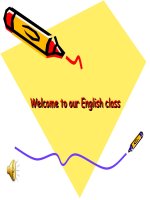unit 5 our hobbies ct bộ gdđt 4 ngô thị hằng thư viện giáo án điện tử
Bạn đang xem bản rút gọn của tài liệu. Xem và tải ngay bản đầy đủ của tài liệu tại đây (105.98 KB, 6 trang )
<span class='text_page_counter'>(1)</span><div class='page_container' data-page=1>
<b>WEEK 7</b>
Date of preparing:
Date of teaching:
<b>UNIT 5: CAN YOU SWIM?</b>
<b>Period 25 - Lesson 1: Part 1, 2, 3: Page 30</b>
<b>I. OVERVIEW</b>
1. Objectives: Students will able to ask and answer questions about what what
someone can/ cannot do
2. Language focus:
- Vocabulary: can, skip, skate, cook swim.
- Sentence patterns: What can you do?-I can dance.
3. Resources: Ss’ book, recording, fresh cards, puppets, posters,…
<b>II. PROCEDURE</b>
<b>Steps</b> <b>Learning activities</b> <b>Language focus</b> <b>Modes</b>
1. Warm up - Use flashcards to revise the verbs
to talk about activities Ss learnt.
activities: Swim,
ride, draw, sing,..
- Whole class
2.Look, listen
and repeat
- Have them look at the four
pictures to discuss the context in
Which the language is used. Ask
them questions such as who are
<i>they? Where are they? and What</i>
<i>are they talking about?</i>
- Explain the meaning of the
phrases can dance, can sing, and
<i>can’t dance. </i>
- Play the recording a few times for
Ps to listen and repeat. Do choral
and individual repetition, pointing
to the characters speaking.
- Play the recording again for them
to listen and repeat.
New words:
<i>can dance, can</i>
<i>sing, and can’t</i>
<i>dance.</i>
- Whole class
- Whole class
- Whole class
- Whole class
- Individual
- Whole class
3. Point and
say
- Have Ss look at the pictures to
understand how the language is
used in different contexts.
- Call a few pairs to act out the
dialogue in front of the class.
* Work in pairs. Tell your partners
<i><b>what you can do.</b></i>
<i><b>What can you? </b></i>
<i><b>I can…</b></i>
</div>
<span class='text_page_counter'>(2)</span><div class='page_container' data-page=2>
- Tell Ss that they are going to
practise using What can you? and I
<i>can…</i>
- Ask them to work in pairs.
-Select some pairs to role-play in
front of the class.
- Whole class
- Individually
- Pairs
4. Homelink Ss have to ask and answer questions
about what someone can/ cannot do
-Well−prepair for next lesson, page
31.
“What can you
do? I can…..”
- Whole class
*********************************
<b>UNIT 5: CAN YOU SWIM?</b>
<b>Period 26 - Lesson 1: Part 4,5,6: Page 31</b>
<b>I. OVERVIEW</b>
1. Objectives: Ss will able to:
- Listen and tick the correct pictures.
- Swap their answers and play “Guessing game”.
2. Language focus: Revise the familiar words and sentence patterns learnt in
the previous lesson.
3. Resources: Ss’ book, recording, fresh cards, puppets, posters,…
<b>II. PROCEDURE</b>
<b>Steps</b> <b>Learning activities</b> <b>Language focus</b> <b>Modes</b>
1. Warm up - Revising the question What can you
do? And the answer I can…..
What can you?
I can… - Whole class
2. Listen and
tick
- Have Ps look at the pictures to
identify the similarities and differences
Check understanding.
- Play the recording a few times. Ask
Ps to listen to the recording and tick the
correct pictures.
- Get Ps to swap their answers before
checking as a class. Monitor the
activity and offer help if necessary.
- Listen and tick
Key: 1.a; 2.c; 3.a
- Whole class
- Whole class
- Individual
- Pairs
3. Look and
write
- Ask Ss to look at the four pictures to
identify what the character in each
picture can do.
- Give times to do the task
- Look and write
Keys:
</div>
<span class='text_page_counter'>(3)</span><div class='page_container' data-page=3>
independently. Go around and offer
help, if necessary.
- Get them to swap their answers before
checking as a class. If there is enough
time, call some Ps to read aloud the
complete sentences.
- Pairs
- Individual
- Pairs
5. Let's play - Stick pictures of a dog, a fish and a
parrot on the board.
- Point to a picture and ask some
questions about the animals.
- Divide class in to five groups.
- The groups take turns asking and
answering questions.
- play the game
- Whole class
- Whole class
- Individual
6. Homelink - Make a card
- Well−prepair for next lesson, page 32.
- Whole class
*************************************
<b>UNIT 5: CAN YOU SWIM?</b>
<b>Period 27 - Lesson 2: Part 1, 2, 3: Page 32</b>
<b>I. OVERVIEW</b>
1. Objectives: Ss will able to ask and answer question about whether
someone can do something
2. Language focus:
- Vocabulary: play table tennis, volleyball, play the piano, play the guitar.
- Sentence patterns: Can you……….?-yes, I can/No, I can’t.
3. Resources: Ss’ book, recording, fresh cards, puppets, posters,…
<b>II.PROCEDURE</b>
<b>Steps</b> <b>Learning activities</b> <b>Language focus</b> <b>Modes</b>
1. Warm up - Calling some Ss to the front of the
class to talk about what they can or
cannot do.
- talk - Whole class;
individualy
2.Look,
listen and
repeat
- Have them look at the pictures to
understand the context in which the
language is used. Ask them questions
such as Who are they? Where are
<i>they? and What are they saying?</i>
- Play the recording two or three
times for Ps to listen and repeat the
language. Do choral and individual
- Whole class
</div>
<span class='text_page_counter'>(4)</span><div class='page_container' data-page=4>
repetition, pointing to the characters
speaking.
- Play the recording again for Ps to
listen and repeat.
- Individual
3. Point
and say
- Ask ss to look at the four pictures to
identify what the boy can do in each
pictures
- Teach the phrase play table tennis,
play volleyball, play the piano and
play the guitar.
- Ask Ps to work in pairs, pointing to
the characters speaking.
- Call on a few pairs to act out the
dialogue in front of the class. Check
as a class and correct pronunciation, if
necessary.
New words:
play table
tennis, play
volleyball, play
the piano and
play the guitar.
- Whole class
- Whole class
- Individual
4. Let’s
talk
- Tell Ss that they are going to revise
what they have learnt in Parts 1 and 2.
Revise Ps how to use the models
- Have Ps work in pairs, acting out
- Call on a few pairs to act out the
dialogue in front of the class. Correct
the pronunciation, if necessary.
Can you…….?
Yes, I can
No, I can’t.
- Whole class
- Pairs
5.
Homelink
- Practice asking and answering
questions about whether someone can
do something.
- Well−prepair for next lesson, page
33.
Can you…….?
Yes, I can
No, I can’t.
- Whole class
*****************************
<b>UNIT 5: CAN YOU SWIM?</b>
<b>Period 28: Lesson 2 (4, 5, 6) page 33</b>
<b>I. OVERVIEW</b>
</div>
<span class='text_page_counter'>(5)</span><div class='page_container' data-page=5>
2. Language focus:
- New words: Revision
- Functions: Revision
3. Resources: Ss’ book, recording, fresh cards, puppets, posters,…
<b>II. PROCEDURE</b>
<b>Steps</b> <b>Learning activities</b> <b>Language focus</b> <b>Modes</b>
1. Warm up - Call some pairs to ask and answer
about ability using model
Can you….?Yes I
can/No ,I can’t
-Whole class
- Pairs
2.Listen and
number
- Tell Ss that they are going to listen to
four dialogues and number the
pictures.
- Focus their attention on the pictures
so that they can understand how the
language is used in different contexts.
Help them to identify the similarities
and differences by explaining who the
characters are and what they can do.
(Check understanding)
- Play the recording a few times for Ss
to listen and number the pictures.
- Get Ps to swap their answers before
checking as a class.
- Ask Ss to give their answers.
- Replay the recording for Ss to check
their answer.
- Ask Ss some questions to check Ss’
comprehension.
Listen and number
Key:
1d; 2a; 3c; 4b
- Whole class
- Whole class
- Individual
Pairs
- Whole class
3. Look and
write
- Tell Ss that they are going to read the
dialogues and fill the gaps, used
picture cues.
- Ask Ss to read the dialogues
individually and do the task. Go
around and offer help when necessary.
- Get Ps to swap their answers before
checking as a class.
- Look and write
Key:
1. No, I can’t
2. Yes, I can
3. No, I can’t
4. No, I can’t
- Whole class
- Individual
- Pairs
4. Let’s sing - Have Ss read each line of the lyrics.
- Play the recording all the way
through.
</div>
<span class='text_page_counter'>(6)</span><div class='page_container' data-page=6>
- Ask Ss to do choral
- Divide the class in to two groups - Individual
5. Homelink - Ss sing the song at home
- Well−prepair for next lesson, page
34.
- Whole class
</div>
<!--links-->









